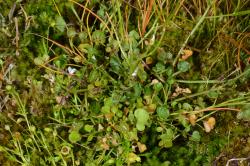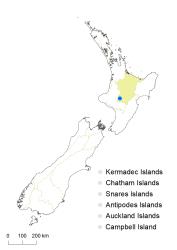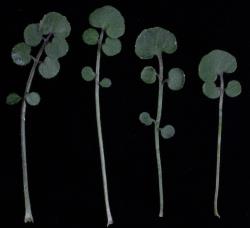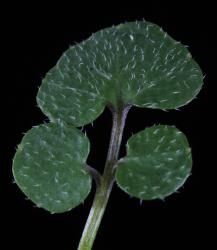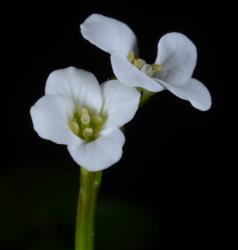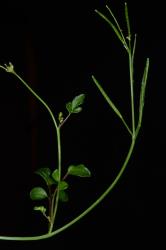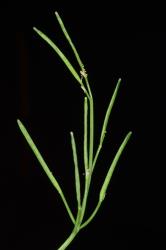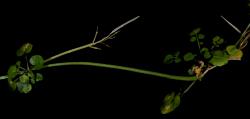Perennial herb, single or several rosettes, with 1–10 short lateral branches, stems and branches 0.5–1.5 mm diam. Leaves up to 45 mm long, pinnatisect; lamina 3.3–15.0 × 3.5–13.0 mm, green, semi-coriaceous, sparsely to moderately hairy or glabrate on adaxial surface, margin and petiole, glabrous or sparsely hairy on abaxial surface; terminal pinna 3.3–12.0 × 3.5–13.0 mm, simple, orbicular-reniform to reniform, apex obtuse with an inconspicuous hydathode, base usually cordate, sometimes obtuse or truncate. Lateral pinnae 0–4, 2.0–4.0 × 1.5–2.5, orbicular to orbicular-rhomboid, petiolule absent or up to 1.2 mm long; petiole up to 30 mm long; hairs 0.1–0.2 mm long, spreading to patent. Cauline leaves similar to rosette leaves but distally smaller, narrower, with fewer lateral pinnae. Inflorescence with 1–4 racemes, each raceme 4–12-flowered, terminal flowers often in a cyme-like cluster; peduncle up to 140 mm long, 0.5–1.5 mm diam. at base, prostrate, decumbent to seldom upright, glabrous. Pedicels 1.5–8.0 mm long, 0.2–0.8 mm diam., glabrous or rarely hairy, spreading. Sepals 1.8–2.2 × 0.5–1.1 mm, elliptic-oblong to narrowly elliptic-oblong, ± saccate, green, glabrous; margin with a thin membranous white edge, apex obtuse; base truncate. Petals 4; 3.8–5.0 × 1.2–1.5 mm, white, limb obovate to broadly elliptic-obovate; apex obtuse; base cuneate, tapering to a c. 1 mm-long claw. Stamens 6; median filaments 4, 2.4–2.7 mm long; lateral filaments 2, 2.1–2.2 mm long; anthers 0.3–0.4 mm long, cream to pale yellow, when dehiscent held at a similar height to or slightly below the stigma. Ovary 2.2–2.4 mm long, 0.3–0.4 mm diam., ± terete, green, glabrous; ovules 18–24; style 0.1–0.2 mm long, ± terete; stigma 0.3–0.4 mm diam. Siliques 12.0–23.0 × 1.3–1.8 mm, glabrous, style 1.0–1.5 mm long; valves green at maturity and when dehiscent, replum 0.3–0.4 mm wide. Seeds 1.1–1.4 mm long, 0.9–1.0 mm wide, 0.4–0.5 mm thick, orbicular-oblong to broadly oblong, light green to brown-green; wing absent.
Cardamine panatohea is distinguished from all other indigenous and naturalised species in New Zealand by its decumbent, sprawling racemose inflorescences that have leafy rosettes in the axils of the lateral branches. It differs from C. corymbosa in its thicker leaves and moderate covering of scattered hairs on the adaxial surface.
North Island: Volcanic Plateau.
Cardamine panatohea is known from two tributary streams in the upper Mangaturuturu Stream headwaters, Mt Ruapehu, Tongariro National Park, Central North Island, New Zealand.
Cardamine panatohea occurs in two closely located but separate seepages and associated alpine flush vegetation at 1600‒1700 m elevation. The two habitats occupied are water-saturated, with plants growing threaded through thick, floating bryophyte-dominated mats composed of Breutelia pendula and Riccardia furtiva in sites partially sheltered by the grasses Hierochloe redolens and Chionochloa pallens subsp. pallens.
Cardamine panatohea is assessed as having a conservation status of Threatened, Nationally Critical, with the qualifier Data Poor (de Lange et al. 2018). The qualifier Data Poor indicates that additional information is on species population trends.
Flowering November–March; Fruiting December–April.



